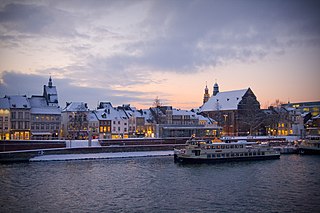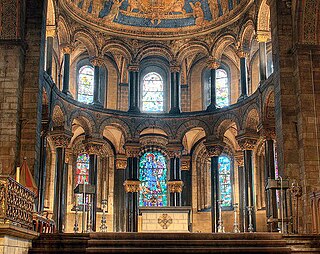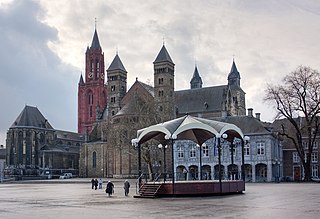History of the building
The museum is housed in the so-called Spanish Government building, one of the oldest non-religious buildings in Maastricht, facing the city's main square, Vrijthof. The building was originally part of the ecclesiastical territory of the chapter of the church of Saint Servatius and was probably built for one of the chapter's canons. In the early 16th century the house was rebuilt and enlarged. At that time the facade on the ground floor was largely blind, except for an arched gateway that led into the courtyard. The three late Gothic windows on the first floor date from this period. Two of them show the pillars of Hercules and the motto of Charles V, Holy Roman Emperor: 'Plus ultra'. The third window, in the middle, carries the symbols of Habsburg power: the double-headed eagle with the coat of arms of Habsburg and Castile.
A little later, an arcade in Liège Renaissance style was added on the side of the courtyard which bears similarity to the architecture of the main courtyard of the Prince-Bishops' Palace in Liège. The colonnade frieze has three sculpted medallions with the portraits of (probably) Charles V, his wife Isabella of Portugal and their son Philip II of Spain, who stayed here at several occasions. [1] It was probably here that Alexander Farnese, Duke of Parma and Governor of the Netherlands, signed the declaration that made William the Silent, leader of the Dutch Revolt, an outlaw. It was during this period that the building acquired its name Spanish Government building (Dutch: Spaans Gouvernement).
In the 18th and 19th centuries the interior of the building was altered several times. It was during this time that extra windows were put in place on the ground floor. In 1766, the Parisian printer and editor Jean-Edmé Dufour bought the building and used it as a print shop. It was from here that many books prohibited in France were smuggled into the country. [2]
In 1913 the building was publicly sold. Part of it was demolished and replaced in 1923 by a building that is now in use as a bank (corner St Jacobstraat). The rest of the building was restored by Victor de Stuers and presented to the city of Maastricht in order to house a local history museum (which did not happen until recently). From 1969 to 1973, and again from 2010 to 2012, thorough restorations took place.
The museum
In 1954, the wealthy The Hague couple Frederik Wagner and Ambrosina de Wit bequeathed their art collection to a foundation based in the city of Maastricht. Since 1973 the Wagner-De Wit collection has been on display in what was then called Museum Spaans Gouvernement. The pavilion room in the courtyard was specifically built to house valuable boiseries from a demolished 18th-century Maastricht mansion. Some of the period rooms decorated in the so-called Liège Régence style, are used for functions.
From 2010 to 2012 the museum closed for renovations and extensions. The renovation included a partial restoration of the originally largely blind facade of the Spanish Government building. The extension consisted of adding a neighbouring building to the museum's exhibition space, as well as roofing over the courtyard. The enlarged museum is now about two and a half times bigger than the old premises. The museum re-opened in March 2012 with some rooms dedicated to important figures from Maastricht history, e.g. the emperor Charles V, the printer Jean-Edmé Dufour, the architect Mathias Soiron, the entrepreneur Petrus Regout and the draughtsman Philippe van Gulpen. Exhibitions focussed on local arts and crafts, e.g. Maastricht silver and Maastricht pistols. From 2014 the emphasis shifted to local and regional artist from the late 19th and early 20th century. In 2019, the museum announced that it would only show photography from then on. Subsequently, it changed its name to Fotomuseum aan het Vrijthof.
Museum aan het Vrijthof is a private museum that receives no government funding. In 2011, TEFAF became a major sponsor. In honour of this, the museum renamed one of the period rooms TEFAF-zaal.
The collection
The museum's original collection consisted of the Wagner-De Wit bequest and some later acquisitions. The collection, brought together by the artistic couple, contained art and artifacts from a wide array of periods and regions, some of which has been discarded by the current directors. The emphasis in the collection was on Dutch and Flemish painting from the 17th century (Dirck van Baburen, Willem de Poorter, Adriaen van de Venne, Cornelius van Poelenburgh, Johannes Lingelbach, Egbert van der Poel, Nicolaes Moeyaert, Nicolaes Berchem, Lodewijk de Vadder, Jacques d'Arthois, Pieter Casteels III) and paintings from the Hague School (Jozef Israëls, Jan Hendrik Weissenbruch, Willem Bastiaan Tholen, George Hendrik Breitner and the brothers Jacob, Matthijs and Willem Maris). The Wagner-De Wit collection also included sculpture from the Middle Ages and Renaissance period, tapestries and furniture from the 16th, 17th and 18th centuries, glass and crystal objects, antique coins, and artifacts from the Far East.
Most of the objects collected by Frederik Wagner and Ambrosina de Wit have not been seen for decades. As several paintings from the collection appeared in auctions around 2010–2013, it is likely that these were sold to fund the renovation and expansion of the building. [3] The museum does not provide any information on this subject and being a private association it is not bound to.
Over the years, the collection expanded to include Maastricht silver from the 18th century (some on loan from the Bonnefantenmuseum), Maastricht and Liège pistols from the 18th and 19th centuries, and some Maastricht paintings from the early 20th century. Since 1997 the Bonhomme-Tielens bequest (antique clocks and Maastricht silver) was part of the museum collection. It is not clear what has happened to this part of the collection, as the museum shows exclusively photography since 2019.
The museum does not have a photography collection of its own. All exhibitions consist of loans.

Maastricht is a city and a municipality in the southeastern Netherlands. It is the capital and largest city of the province of Limburg. Maastricht is located on both sides of the Meuse, at the point where the Jeker joins it. Mount Saint Peter (Sint-Pietersberg) is largely situated within the city's municipal borders. Maastricht is adjacent to the border with Belgium and is part of the Meuse-Rhine Euroregion, an international metropolis with a population of about 3.9 million, which includes the nearby German and Belgian cities of Aachen, Liège and Hasselt.

The Frans Hals Museum is a museum located in Haarlem, the Netherlands.

The Bonnefanten Museum is a museum of fine art in Maastricht, Netherlands.

The Kunstmuseum Den Haag is an art museum in The Hague in the Netherlands, founded in 1866 as the Museum voor Moderne Kunst. Later, until 1998, it was known as Haags Gemeentemuseum, and until the end of September 2019 as Gemeentemuseum Den Haag. It has a collection of around 165,000 works, over many different forms of art. In particular, the Kunstmuseum is renowned for its large Mondrian collection, the largest in the world. Mondrian's last work, Victory Boogie-Woogie, is on display at the museum.

Mosan art is a regional style of art from the valley of the Meuse in present-day Belgium, the Netherlands, and Germany. Although in a broader sense the term applies to art from this region from all periods, it generally refers to Romanesque art, with Mosan Romanesque architecture, stone carving, metalwork, enamelling and manuscript illumination reaching a high level of development during the 11th, 12th and 13th centuries.

Amsterdam Impressionism was an art movement in late 19th-century Holland. It is associated especially with George Hendrik Breitner and is also known as the School of Allebé.

The Curtius Museum is a museum of archaeology and decorative arts, located on the bank of the river Meuse in Liège, Belgium, classified as a Major Heritage of Wallonia.

Samuel Iperuszoon, Knight Wiselius was a successful Dutch lawyer and a prominent Patriot and democrat, involved in the dismantling of the Dutch East India Company (VOC) and the negotiations over the Cape. Wiselius was a witty, Voltairian spirit with political views far ahead of his time who would end his days writing dramas on Classical themes. Wiselius corresponded with nearly all the main players at the time of the Batavian Republic and it would be impossible to know that period completely without his carefully kept and neatly written correspondence. He was also a poet, historian and superintendent of the police.

The European Fine Art Fair (TEFAF) is an annual art, antiques and design fair organized by The European Fine Art Foundation in the MECC in Maastricht, Netherlands. It was first held in 1988. The ten-day fair attracts about 75,000 visitors and is considered one of the world's leading art fairs.

The Treasury of the Basilica of Saint Servatius is a museum of religious art and artifacts inside the Basilica of Saint Servatius in Maastricht, Netherlands.

Maastricht silver is a collective name for silver objects produced in Maastricht, Netherlands, mainly in the 17th and 18th centuries, when the town was a major centre for silversmithing.

HJIM van Gasteren is the pseudonym of Henriëtte Johanna Ignatia Maria van Gasteren, a Dutch multimedia artist, known for her, sometimes controversial, self-portraits. She was formerly known as Lilith Love but she changed her artist name in 2020. Recurring themes in her work are: identity, femininity, female archetypes, gender bending, freedom and equality.
The following is a timeline of the history of the municipality of Maastricht, Netherlands.
Nico Jesse was a Dutch humanist photographer and photojournalist and later a commercial and advertising photographer. Originally a physician, he combined his work as a doctor with his passion for photography until, in 1955, he gave up his medical practice to devote himself exclusively to photography, producing imagery for several companies’ annual reports and business documents. He also made a large number of books about cities and countries in Europe and mounted exhibitions of the images, the most famous being Women of Paris (1954), and contributed to a mass observation project of Nazi-occupied Utrecht. In 1962 Nico Jesse took up his original profession again and at his death in 1976, left a large photographic oeuvre, in which people and their everyday activities are the focus.

Willem Lenssinck is a Dutch-German sculptor and designer.

Vrijthof is a large urban square in the centre of Maastricht, Netherlands. The square developed from an ancient Roman and Frankish cemetery into a semi-private space that belonged to the Collegiate Church of Saint Servatius. In the 19th century, it became the town's main square. It is surrounded by important heritage buildings, museums, a theatre, and a range of hotels, restaurants, and bars. The square is regularly used for public events.

The Crosier Monastery or Monastery of the Crutched Friars is a former monastery of the Order of the Holy Cross in Maastricht, Netherlands. The well-preserved convent buildings house a five-star hotel, the Kruisherenhotel. Having survived more or less in its entirety, it is a rare example in the Netherlands of a Gothic monastery. The buildings from the 15th and 16th century constitute three listed buildings (Rijksmonuments). The more or less intact monastery archive is unique in the Netherlands.

The Ansembourg Museum is a museum in the Belgian city of Liège. It is housed in the hôtel d'Ansembourg on Féronstrée in the historic heart of the city.

The Fotomuseum Den Haag is a museum in the field of photography in The Hague. The museum was founded in 2002 as part of the Kunstmuseum Den Haag and works closely with the Print Room of the Leiden University Library.






















